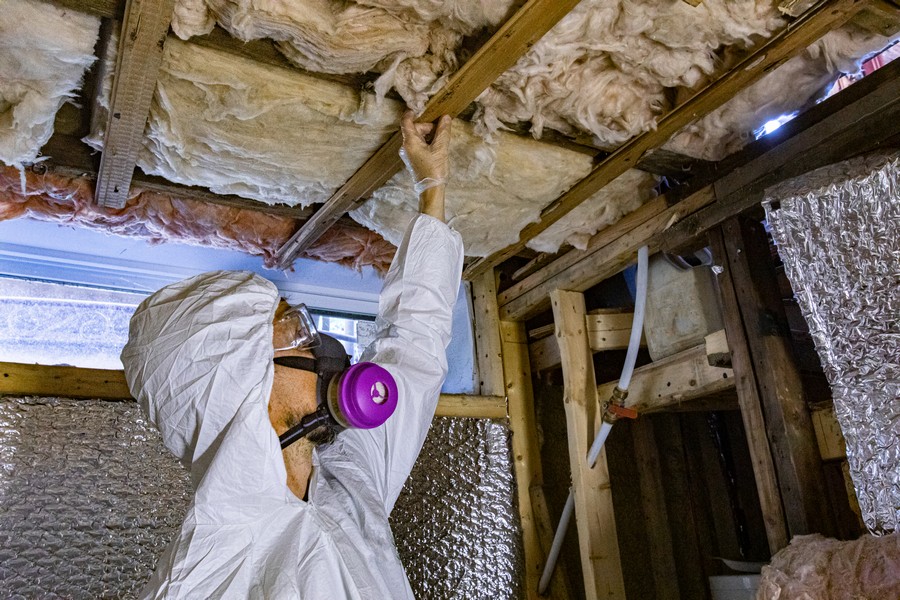Understanding Dry Rot
Dry rot is a type of timber deterioration caused by a wood-decaying fungus that consumes the components which give it strength and firmness. It was once utilised to describe any fungal decay of cured wood in vessels and structures, resulting in a darkened, harmed, and cracked condition.
The life cycle of dry rot fungus can be divided into four stages. Initially, fine orange dust-like spores are present. If the environment is sufficiently damp, white filaments named hyphae will sprout. These then combine to form a mass known as mycelium as they germinate.
The fruiting body is the final step, releasing new spores into the atmosphere.
Dry rot necessitates a moisture content of approximately 20% in the wood to initiate its growth. Contrary to its title, it does not flourish in arid conditions.
Living in a very humid or damp environment? Keep an eye out for your windows – they may be giving you early warning that dry rot is setting in. Ensure your home has adequate ventilation to prevent moisture accumulation and avoid its consequences.
When a leak or damp rot is present, it’s essential to pinpoint and remove the cause of moisture before treating the fungus.
Dry rot is often concealed in walls or subflooring, where it can’t be seen. If not noticed swiftly, it can cause serious harm to wood and spread throughout the abode.
A surveyor should be consulted to assess the full extent of dry rot damage, and removal of plastering may be necessary. As with wet rot, affected wood will likely have to be replaced. Fungicides can be employed as a treatment option.
Most Frequent Indicators of Dry Rot
Signs of Dry Rot
- Damaged or decaying wood needs to be replaced.
- An unpleasant musty or damp smell.
- Deep cracks in the wood grain;
- Wood that crumbles at the slightest touch is brittle.
- Patches of rust-hued spore powder were scattered about.
- On the wooden surface, there are grey streaks.
- The fruiting bodies of dry rot resemble large mushrooms.
Detecting Dry Rot with Your Nose
The aroma of dry rot is moist, musty and mushroomsque. This is one of the earliest warnings you’ll encounter and a definite indication that dry rot has started to develop and spread in the residence.
Signs and Symptoms of Timber Damage
A sign of dry rot in a home could be the changing state of wood objects. Floors, door frames, and skirting boards may become dry and brittle to touch, crumbling in your hands with a darker hue. The most obvious evidence is cuboidal cracking – splitting into cubes 50 mm wide. Additionally, hyphae or white fungal growth resembling cobwebs may appear; if so, dry rot is present.
You may notice other types of harm caused by a lack of moisture, including cuboidal cracks and distortion with a shrivelled look, as well as dryness and crumbling. Floors will feel spongy too when walked upon, showing signs of deterioration.
Discovering the Benefits of Strands
Signs of dry rot can be seen in the grey strands appearing on wood, which may appear to be cobwebs upon initial inspection. These threads represent the timber’s quest for water as well as the direction taken by dry rot.
Uncovering the Wonders of Mycelium
Mycelium is the penultimate stage in the dry rot life cycle. It’s easy to spot with its white, cotton-wool like appearance; however, finding it can be tricky as it thrives in dark, damp areas with little air flow – usually those hard-to-reach places underneath the floorboards.
Fruiting Bodies: The Reproductive Structures of Fungi
The fruiting body of dry rot is easily recognisable by its mushroom-like appearance, featuring fleshy pancake-like growths and an orange-ochre top with prominent pores.
Spores and Dust: Nature’s Building Blocks
The fruiting body stage of dry rot results in the presence of spore dust, clearly identifiable by its rusty red-brown colour. This is a sign that it has reached its most advanced state and is seeking new sources of moisture, potentially spreading to other surfaces.
Comparing Dry Rot and Wet Rot
Surveyors often receive questions about the distinctions between dry and wet rot, both of which are associated with fungal decay of timber. Generally speaking, these two types of rotting are the most commonly encountered in homes.
The two types of rot are both caused by fungal spores that were already in the wood and which expand when humidity is high. The scientific names for these fungi are Serpula lacrymans (dry rot) and Coniophora puteana (wet rot).
It is essential to differentiate between the two types, as untreated they can cause severe structural issues.
It is recommended to contact a professional surveyor if you think your property has dry or wet rot. Brighton Damp Treatments can provide assistance with any damp problem and carry out timber and damp surveys.
What to Do if You Suspect Dry Rot
If you spot any of the dry rot symptoms mentioned above, we strongly recommend that you get your home inspected. Dry rot is a significant issue and if found, appropriate steps must be taken to deal with it. We may send an expert to assess and identify the signs of dry rot in your property as well as make further suggestions for action.
Detecting dry rot early and effectively is only half the battle. Recognising a problem promptly makes it much easier to halt and stop its spread, offering substantial savings. Crucial inspection of dark, damp, heated areas with no air movement is essential; these spots plus sub-floors and loft roofs are likely places for dry rot to appear and propagate. Older homes are more vulnerable but newer ones can also suffer from this affliction.
Don’t hesitate to contact Brighton Damp Treatments if you require advice concerning any damp and wood rot problems.
Properties Prone to Rotting
It is likely that your property, be it a flat, apartment, bungalow or detached house, is prone to moisture and thus the timbers of your home may suffer from rot.
Rot can reach up to 300mm each month, depending on the atmosphere inside your home. You likely deduced that dry rot derives its name as infected wood tends to become dehydrated and fragile. This infection strips timber of its essential nutrients and strength.
Wood needs to be humid and have a moisture content of 20% or higher for rot to appear. Without dampness, there is no possibility of rot.
Does Dry Rot Spread?
Dry rot is a fungus that thrives and proliferates. It feeds on wood voraciously, relentlessly tracking down new sources of nutrition when needed. Fresh timber serves as an appetising meal for the fungus, allowing it to quickly spread across a property in humid conditions.
How to Eliminate Dry Rot
In order to prevent serious damage, it is advisable to tackle dry rot without delay. If you believe the timber in your house may be affected by dry rot, the wisest step would be to book a dry rot inspection promptly.
Brighton Damp Treatments offers a compelling selection for anyone in the Brighton area. Our experienced, qualified surveyors can visit any home to provide comprehensive evaluations.
Our specialists, who are experienced and qualified, will professionally, safely and compassionately tackle your dry rot issue promptly to protect your residence.
Our surveyor, well-informed and experienced, will:
1. Carry out a detailed inspection of the property;
2. Assess any repairs needed and provide an estimate of costs;
3. For residential properties they will also assess compliance with current building regulations.
Our surveyor is equipped to:
- Conduct a thorough examination of the property;
- Estimate expenses for required repairs;
- Determine if residential buildings conform to current construction codes
- Identify the rot fungus accurately and ascertain its extent and impact.
- Identify the source of the moisture.
- In order to combat the deterioration, create a detailed plan.
- Our team will eliminate any building material that has been damaged by dry rot, including wood and plaster.
- We will then replace the timber and secure it to restore the structure’s strength.
- The fungicidal treatment necessary to combat the affected area will be applied to both masonry and wood in a secure fashion.
- Damaged walls and ceilings will be restored with fabric, as per our report.
- Our team will give you honest, accurate advice on the optimal strategy to resolve your building’s rot issue throughout.
If you think your property has dry rot, get in touch with us immediately for advice or book a survey by calling 01273 920588 or sending an email.



